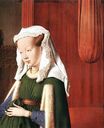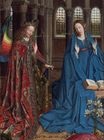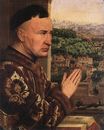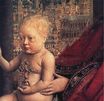Jan van Eyck - The Annunciation 1434-1436
 |
 |
 |
 |
 |
 |
 |

The Annunciation 1434-1436
97x37cm oil on canvas transferred from panel
National Gallery of Art, Washington, DC, US
<< Previous G a l l e r y Next >>
From National Gallery of Art, Washington:
The Annunciation described by Saint Luke is interpreted in terms of actuality in this painting, which was probably once the left wing of a triptych. The forms—even that of the archangel—seem to have weight and volume. Light and shadow play over them in a natural way, and with amazing skill, Jan van Eyck has distinguished between the textures of materials ranging from hard, polished stone to the soft, fragile petals of flowers.
Yet religious symbolism speaks from every detail, expounding the significance of the Annunciation, and the relationship of the Old Testament to the New. The structure of the church can be interpreted symbolically; the dark upper story, with its single, stained–glass window of Jehovah, may refer to the former era of the Old Testament, while the lower part of the building, already illuminated by the "Light of the World" and dominated by transparent, triple windows symbolizing the Trinity, may refer to the Era of Grace of the New Testament. The idea of passing from old to new is further manifested in the transition from the Romanesque round–arched windows of the upper story to the early Gothic pointed arches of the lower zone, and also in the depictions on the floor tiles: David beheading Goliath and Samson destroying the Philistine temple are both Old Testament events in the salvation of the Jewish people which prefigure the salvation of humankind through the coming of Christ.